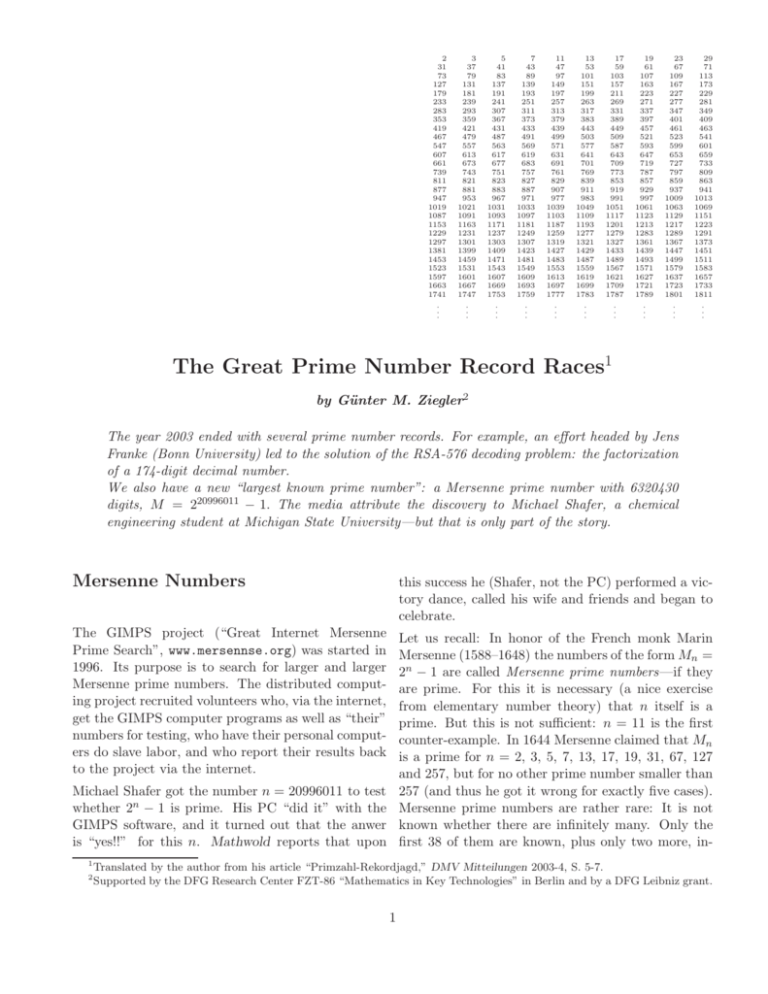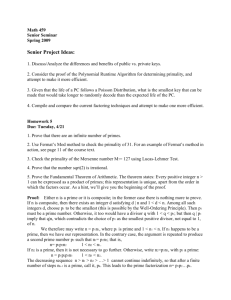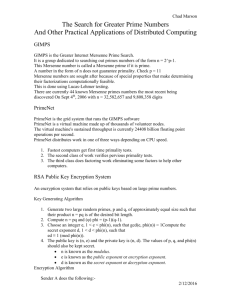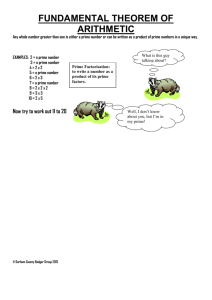The Great Prime Number Record Races1
advertisement

2 31 73 127 179 233 283 353 419 467 547 607 661 739 811 877 947 1019 1087 1153 1229 1297 1381 1453 1523 1597 1663 1741 . . . 3 37 79 131 181 239 293 359 421 479 557 613 673 743 821 881 953 1021 1091 1163 1231 1301 1399 1459 1531 1601 1667 1747 . . . 5 41 83 137 191 241 307 367 431 487 563 617 677 751 823 883 967 1031 1093 1171 1237 1303 1409 1471 1543 1607 1669 1753 . . . 7 43 89 139 193 251 311 373 433 491 569 619 683 757 827 887 971 1033 1097 1181 1249 1307 1423 1481 1549 1609 1693 1759 . . . 11 47 97 149 197 257 313 379 439 499 571 631 691 761 829 907 977 1039 1103 1187 1259 1319 1427 1483 1553 1613 1697 1777 . . . 13 53 101 151 199 263 317 383 443 503 577 641 701 769 839 911 983 1049 1109 1193 1277 1321 1429 1487 1559 1619 1699 1783 . . . 17 59 103 157 211 269 331 389 449 509 587 643 709 773 853 919 991 1051 1117 1201 1279 1327 1433 1489 1567 1621 1709 1787 . . . 19 61 107 163 223 271 337 397 457 521 593 647 719 787 857 929 997 1061 1123 1213 1283 1361 1439 1493 1571 1627 1721 1789 . . . 23 67 109 167 227 277 347 401 461 523 599 653 727 797 859 937 1009 1063 1129 1217 1289 1367 1447 1499 1579 1637 1723 1801 . . . 29 71 113 173 229 281 349 409 463 541 601 659 733 809 863 941 1013 1069 1151 1223 1291 1373 1451 1511 1583 1657 1733 1811 . . . The Great Prime Number Record Races1 by Günter M. Ziegler2 The year 2003 ended with several prime number records. For example, an effort headed by Jens Franke (Bonn University) led to the solution of the RSA-576 decoding problem: the factorization of a 174-digit decimal number. We also have a new “largest known prime number”: a Mersenne prime number with 6320430 digits, M = 220996011 − 1. The media attribute the discovery to Michael Shafer, a chemical engineering student at Michigan State University—but that is only part of the story. Mersenne Numbers this success he (Shafer, not the PC) performed a victory dance, called his wife and friends and began to celebrate. The GIMPS project (“Great Internet Mersenne Prime Search”, www.mersennse.org) was started in 1996. Its purpose is to search for larger and larger Mersenne prime numbers. The distributed computing project recruited volunteers who, via the internet, get the GIMPS computer programs as well as “their” numbers for testing, who have their personal computers do slave labor, and who report their results back to the project via the internet. Let us recall: In honor of the French monk Marin Mersenne (1588–1648) the numbers of the form Mn = 2n − 1 are called Mersenne prime numbers—if they are prime. For this it is necessary (a nice exercise from elementary number theory) that n itself is a prime. But this is not sufficient: n = 11 is the first counter-example. In 1644 Mersenne claimed that Mn is a prime for n = 2, 3, 5, 7, 13, 17, 19, 31, 67, 127 and 257, but for no other prime number smaller than 257 (and thus he got it wrong for exactly five cases). Mersenne prime numbers are rather rare: It is not known whether there are infinitely many. Only the first 38 of them are known, plus only two more, in- Michael Shafer got the number n = 20996011 to test whether 2n − 1 is prime. His PC “did it” with the GIMPS software, and it turned out that the anwer is “yes!!” for this n. Mathwold reports that upon 1 2 Translated by the author from his article “Primzahl-Rekordjagd,” DMV Mitteilungen 2003-4, S. 5-7. Supported by the DFG Research Center FZT-86 “Mathematics in Key Technologies” in Berlin and by a DFG Leibniz grant. 1 cluding the newly discovered M20996011 which is now any) are found. For this one can exploit the fact that divisibility tests for numbers of the form 2n − 1 can also the largest known prime number. It is quite remarkable that numbers with more than be performed very effectively in binary arithmetic. In Phase II one then uses a special case of the socalled “(p − 1)-method” of Pollard (1974), which can be used to find factors of the form q = 2kn + 1, for which q − 1 = 2kn consists of many small prime factors, or (in an improved version) are highly decomposable except that one prime factor may be a bit larger: To find q such that all prime factors are Q smaller than B, one forms the product E := p<B p of all prime numbers that are smaller than B, and then computes x := 3E2n . The gcd of x − 1 and 2n − 1 will then catch the divisor of 2n − 1 one is looking for. six million digits can effectively be tested for primality. This is the genuine scientific (and programming) achievement on which the new record is based—that the number n = 20996011 must be prime is only a little warm-up exercise for the new record. Marin Mersenne, 1588–1648 (Source: http://www-groups. dcs.st-and.ac.uk/∼ history/PictDisplay/Mersenne.html) Primality tests It has been shown only recently that there are exact prime number tests that work in polynomial time— see the report in the May 2003 Notices, pp. 545-552. This was a theoretical breakthrough, but it is not yet suitable for use “in practice.” The GIMPS project applies for each prime n a sequence of more classical tests, which are nicely described at www.mersenne. org/math.htm:3 Only in Phase III the GIMPS project uses a method which is guaranteed to decide whether 2n −1 is prime, the so-called Lucas–Lehmer test (1878, 1930/1935) for Mersenne numbers: Mn is prime if and only if ℓn−1 ≡ 0 mod Mn , where the ℓk is defined recursively by ℓ1 = 4 and ℓn = ℓ2n−1 − 2. To do this computation effectively, one has to square huge numbers really fast modulo 2n − 1. For this the numbers are decomposed into large blocks, and then one works with a special version of a Fast Fourier Transform (FFT), in this case with a FFT with respect to an irrational basis that was introduced by Richard Crandell and Barry Fagin (1994). On the In Phase I one looks for small prime divisors q of 2n − 1. These have to satisfy (again a nice exercise) q ≡ 1 mod 2n and q ≡ ±1 mod 8. Using a modified “Sieve of Eratosthenes” adapted to such factors, prime divisors of Mn up to approximately 40000 (if 3 For algorithmic prime number theory the experts recommend Richard Crandell & Carl Pomerance: “Prime Numbers. A Computational Perspective”, Springer-Verlag, New York 2001. For a computer algebra perspective on primality tests (and lots of other interesting topics) see Joachim von zur Gathen & Jürgen Gerhard: “Modern Computer Algebra”, Cambridge University Press, 2. Auflage 2003. 2 web pages mathworld.wolfram.com of the Mathematica project, which advertise the new record, it is suggested that GIMPS worked with a Mathematica implementation, but that seems to slightly stretch the facts. (The connection they can legitimately make is that Crandell has worked on implementing his method for the prime number tests in Mathematica.) Indeed, GIMPS works with a highly optimized assembly code. They use floating point arithmetic because this is more effective on Intel Pentium processors, but this also means that the errors of floating point arithmetic have to be detected and eliminated separately. company. The security of their method against unauthorized decoding depends on the fact that with current technology it is very difficult to decompose products with 150 or 200 decimal digits into their prime factors. The company “RSA Securities” has even offered prizes for factoring their challenge problems.4 The first of them is/was a prize of $10,000 for factoring the number “RSA-576”: 18819881292060796383869723946165043980 71635633794173827007633564229888597152 34665485319060606504743045317388011303 39671619969232120573403187955065699622 1305168759307650257059 with 174 decimal digits, that is, 576 binary digits (bits). This problem has been cracked by Jens Franke of Bonn University, as reported by Heise Online news service on December 8: The number has factors Primality and factoring Phases I and II of the GIMPS-sequence really do produce divisors in the case of a decomposable Mn , if they find any, but the third and decisive phase doesn’t. In that case the answer will only be “decomposable!” or not, without an explicit prime divisor as a certificate. Thus a complete primality test is performed, but no complete factoring is produced. 39807508642406493739712550055038649119 90643623425267084063851895759463889572 61768583317 and 47277214610743530253622307197304822463 29146953020971164598521711305207112563 And there are good reasons for this: Not even in 63590397527 the special case of Mersenne numbers does one know (87 digits each) and these are prime—which again an effective method for factoring. A method that with the current methods is very easy to verify. For would be able to factor arbitrary numbers with a few his factorization Franke has used the “General Numhundred digits would be interesting and threatening, ber Field Sieve (GNFS).” This method was introbecause the cryptographic methods that guarantee duced by Buhler, Lenstra and Pomerance (1993). It 3 the security of, for example, online banking and the has a running time of exp(O( √ n log n)) for n-digit internet are based on the assumption that factoring numbers; this is not quite polynomial, but is nearly and similar problems (such as computing “discrete so. The GNFS had already been used to factor logarithms”) are computationally hard. the smaller test problems, ranging from RSA-100 to RSA-512, the latter in August 1999. RSA The by now classical example of an encryption method based on the hardness of factoring is the “public key” encryption scheme by Ron Rivest, Adi Shamir and Leonard Adleman published in 1978. This RSA method is currently treated in every new elementary number theory text book, and also used extensively in practice—see the manual pages for ssh on your PC, or the homepage http://www. rsasecurity.com of Rivest, Shamir and Adleman’s 4 http://www.rsasecurity.com/rsalabs/challenges/factoring/numbers.html 3 This achievement is based on the “Special Number Field Sieve (SNFS)”—a faster specialized version of the GNFS, which is applicable only for special numbers, such as those of the form bn ± 1. Record Chase The chase for new records will continue. In 2000, the “Electronic Frontier Foundation” (http://www.eff. org/) has paid their first prize, $50,000, for the first prime number with more than one million digits. For the identification of a prime number with more than ten million decimal digits they have offered a prize of $100,000. This adds to the excitement, and the GIMPS project is looking for fellow combatants, who would enlist their computers for the record chase. More Records And there are even more current records with respect to factorization: Indeed, people are not only trying to test Mersenne numbers for primality, but also to decompose them completely into prime factors. NFSNET (http://www.nfsnet.org) is another distributed computing project, which recently (success announced on December 2) managed in internet joint work to factorize the Mersenne number 2757 − 1 completely. The prime factors 9815263 and 561595591 of this number had been known before, but the 213-digit rest was a hard piece of work: It was now decomposed into the prime factors At the same time, the larger RSA challenge problems wait to be attacked. RSA-640, a number with 193 decimal digits, is the next one on the list: $20,000 has been offered for it. And the next Mersenne number on the hit list of NFSNET is 2811 −1. This project is looking collaborators as well. So, many poor little personal computers will be fed numbers and tortured with prime number tests and decomposition methods, in the hope that their owners might be able to cash in on a part of the fame and glory (and the prize money) for the next record, which surely is soon to be achieved. 57221370220020678242482279750958577491 51312827809388406962346253182128916964 593 and Günter M. Ziegler Inst. Mathematics, MA 6-2 TU Berlin D-10623 Berlin, Germany ziegler@math.tu-berlin.de 24033821640983508088736273403005965446 68900235634433213056506664319381390111 97710904242694120545430727149147426656 77774247325292327559. 4









